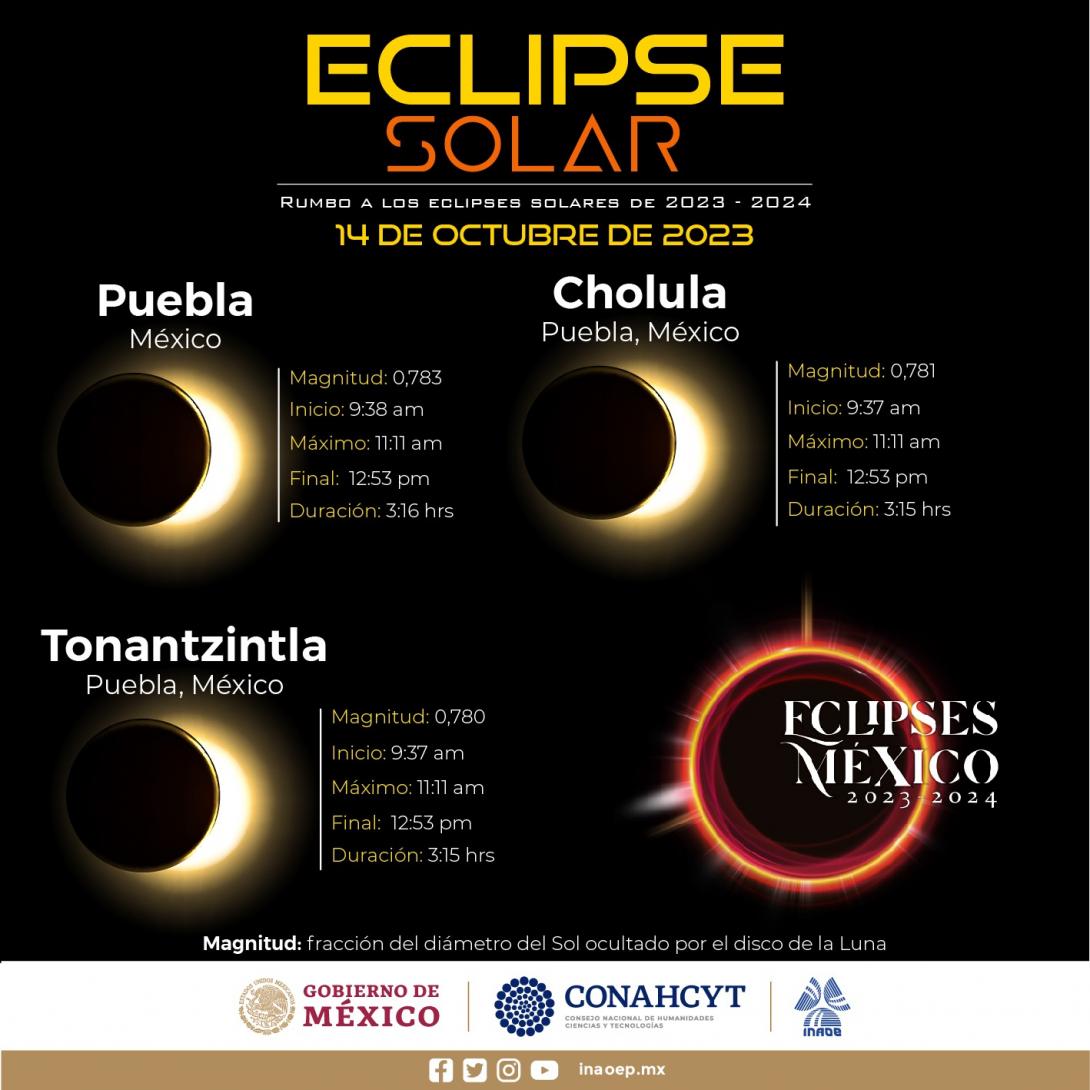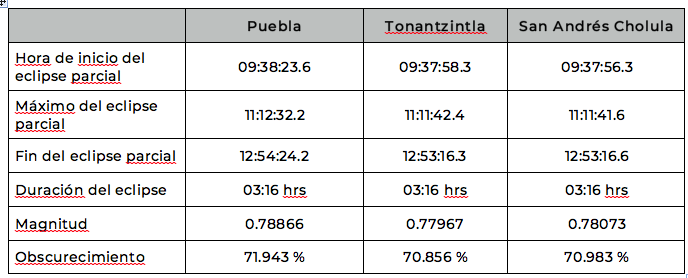PRESS RELEASE
Observation of the solar eclipse on October 14 in more than 80 locations in Puebla
- The eclipse on October 14 will be null in areas of the Yucatan Peninsula and partial in the rest of the country, so we recommend that you approach the experts that make up the National Eclipses Mexico Committee to do it safely.
- In Puebla, through the INAOE, more than 80 locations are being coordinated to observe the eclipse with the help of professional and amateur astronomers. Each one will have at least one telescope.
- The National Committee will distribute pinhole projectors and information material free of charge at its observation headquarters, and will have sunscreens available to visitors.
Santa María Tonantzintla, Puebla, October 9, 2023.- More than 80 locations in 25 municipalities in the state of Puebla will join the observations that, on the occasion of the annular solar eclipse on October 14, are organized by the National Institute of Astrophysics , Optics and Electronics (INAOE), Conahcyt center, and the National Committee of Eclipses Mexico, in collaboration with local institutions and groups.
That day, from 9 a.m. to 1 p.m., in parks, universities, schools, gardens, esplanades, alleys, squares, libraries and houses of culture in more than 15 Puebla municipalities, interested people will be able to observe this spectacular astronomical phenomenon safely. the hand of astronomers, professionals and amateurs, and popularizers.

In fact, with the aim that the next eclipse can be observed safely, the Mexican National Eclipse Committee, of which the INAOE is a part, has carried out an intense training campaign for teaching staff, outreach groups and the public. in general. As a result of these days, which have reached more than five thousand people, there will be, not only in Puebla, but throughout the country a large number of venues where people can come to observe the eclipse safely.
From Puebla, the INAOE and the VIEP of the BUAP developed the asynchronous online course “Development of skills for the training of instructors to accompany the safe observation activities of the 2023-2024 eclipses”, which has served nearly a thousand attendees and will remain open to continue training people until the next eclipse. The league is: https://sites.google.com/viep.com.mx/eclipses
On the other hand, thanks to the support of institutions, private initiatives and local governments, the Mexican National Eclipse Committee will distribute free pinhole projectors, posters and informative videos, and will have sunscreens available to visitors. In addition, in order to achieve safe observation of the eclipse in all communities, the information is also available in several of the languages spoken in Mexico, such as Mixe, Maya, Mam, Tojolabal, Zoque, Tzoztil, Chuj, Mocho, Kaqchikel , Yaqui, Q'anjob'al, P'urhépecha, Hñähñu (Otomí), Náhuatl and Mazahua, among others.
In addition to the INAOE, the Committee has the participation of institutions such as the Institute of Astronomy (IA), the Institute of Radio Astronomy and Astrophysics (IRyA), the Institute of Physical Sciences (ICF) and the National School of Higher Studies Unidad Mérida (ENES). ) of UNAM, El Colegio de la Frontera Sur (ECOSUR), the Autonomous University of Sinaloa (UAS), the Autonomous University of Nuevo León (UANL), the National Polytechnic Institute (IPN), the Metropolitan Autonomous University (UAM), the Universidad Iberoamericana, the National Network of Councils and State Organizations of Science and Technology, A.C., (REDNACECYT), the Network of Planetariums of Quintana Roo, the Planetarium Torreón, the National Coordination of Astronomy Education (NAEC) of the International Astronomical Union ( IAU), the Night of the Stars (NdE), Noche Estelar (NE), Kosmos Scientific of Mexico, the Radio Telescope Network of Mexico, and with the support of groups of amateur astronomers and other civil society organizations.
For those who cannot attend one of the venues in person, the Committee is preparing the real-time transmission of the eclipses from various points to follow the trajectory as the shadow of the Moon passes over the national territory.

Fuente: http://xjubier.free.fr/en/index_en.html.
The INAOE will open its doors for the observation of the eclipse. Here there will be filter telescopes and the historic Schmidt Camera, the solar telescope and the RT5 radio telescope will be open to the public. In addition, at 10:30 a.m. the story 10… 9… 8… Take off! During the event, an immersive experience will be open that consists of a sonification demonstration, an animated passage from the story 10… 9… 8… Take off! And interactive model of the Moon.
The eclipse on October 14 is the first of two solar eclipses that we will see in our country in six months. The next will be the total eclipse on April 8, 2024, whose totality will pass through part of the states of Sinaloa, Durango, and Coahuila. It will be seen as a partial eclipse in the rest of the country.
For more information visit www.eclipsesmexico.mx
Luis Enrique Erro # 1, Tonantzintla, Puebla, México, Código Postal 72840, Tel: (222) 266.31.00, difusion@inaoep.mx
This work is licensed under a Creative Commons Attribution-NonCommercial-NoDerivs 2.5 Mexico License.


